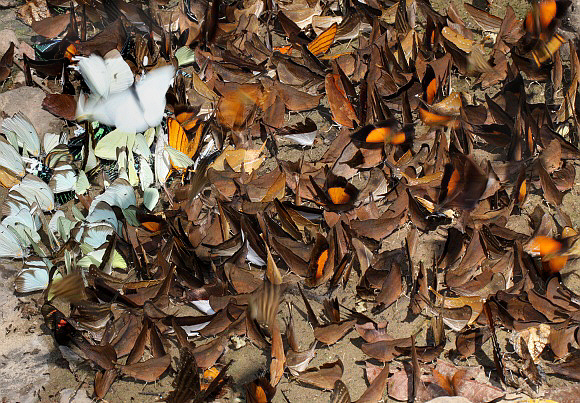 Marpesia furcula oechalia, male, Rio Shima, Satipo, Peru – Adrian Hoskins
Marpesia furcula oechalia, male, Rio Shima, Satipo, Peru – Adrian Hoskins
Introduction
The genus Marpesia is confined largely to the neotropical region, but is closely allied to the Mapwing and Maplet butterflies ( Cyrestis & Chersonesia ) of the Oriental region.
Daggerwings are similar in wing shape to Swordtails and Swallowtails ( Papilionidae ), but the latter have 6 legs whereas Marpesia and all other Nymphalidae genera have only 4 legs. Another feature to look for is the antennae. In all Papilionids these are recurved at the tip, but in Marpesia they are straight. In total there are 17 Marpesia species, all with the same wing shape as egina, except for petreus which has 2 tails on each hindwing and a deeply scalloped outer margin to it’s forewing.
Marpesia furcula produces 2 distinct forms. The normal orange form oechalia, is also known by the junior synonym hermione. A beautiful form known as iole also occurs in which an intense iridescent purple sheen overlays the golden orange basal area – some authors including d’Abrera and DeVries treat this as a separate species.
The female of furcula is duller than the male and has a series of thin dark wavy lines in the basal area, and 5 white subapical spots. It can be confused with the female of tutelina, but the lines in the basal area of that species are broader.
Marpesia furcula occurs from Nicaragua to Bolivia and Argentina.
 Marpesia furcula oechalia, Tingo Maria, Peru – Adrian Hoskins
Marpesia furcula oechalia, Tingo Maria, Peru – Adrian Hoskins
Habitats
This species inhabits evergreen rainforest, at altitudes from sea level to about 1400m. In common with several other Marpesia species furcula is subject to periodic mass emergences and spectacular migrations. In August 2012, I encountered such an event while walking towards our campsite at Rio Shima in Peru. I stopped to do a quick count and estimated that about 100 furcula were passing me per minute as I stood on a logging trail running alongside the river. The migration continued for well over 4 hours during which time at least 10,000 butterflies passed by, all flying in the same direction. Approximately 50% of these were furcula, the remainder consisted of about 20 other species among which were Heliconius melpomene, Consul fabius, Phoebis neocypris, Eueides aliphera, Doxocopa agathina, Panacea prola, various Eunica and Adelpha species, and several Pierids. Upon arrival at our campsite I found another 2000 or more furcula swarming around the edges of 2 large pools. By the day the migration had slowed to a trickle, although it continued for 3 more days.
 Marpesia furcula oechalia, swarming at Rio Shima, Peru – Adrian Hoskins
Marpesia furcula oechalia, swarming at Rio Shima, Peru – Adrian Hoskins
Lifecycle
I have no data relating to furcula, but the following characteristics are applicable in general to the genus Marpesia : The eggs are white or yellowish, and laid singly on the foliage of trees and shrubs in the family Moraceae – including Ficus, Chlorophora, Brosimum and Artocarpus. The fully grown caterpillars are very colourful, typically marked with red and / or yellow spots and stripes. There is a single row of unbranched, recurved spines along the back, and the head is adorned with a pair of very long wavy spines. They feed diurnally and rest on the upper surface of leaves. The pupae are typically pale in colour, marked with blackish spots or blotches, and have wiry filaments projecting from the back of the abdomen and from the head.
 Marpesia furcula oechalia, male, Rio Shima, Satipo, Peru – Adrian Hoskins
Marpesia furcula oechalia, male, Rio Shima, Satipo, Peru – Adrian Hoskins
Adult behaviour
In early morning the males descend from the trees and bask on low foliage, but by about 0900hrs, when temperatures are higher, they gather in two’s and three’s at damp sand-banks or around the edge of muddy pools, often in the company of other Marpesia species such as crethon, themistocles and berania.
Like other Marpesia species they are very active in sunny weather, with a fast and agile flight. They skip about from place to place on sandbanks in search of dissolved minerals, rapidly fanning their wings for a while before settling to feed.
Females are duller, and have white spots in the sub-apical area. They spend most of their time in the forest canopy and are rarely glimpsed.

Marpesia furcula oechalia, male, Rio Shima, Satipo, Peru – Adrian Hoskins
